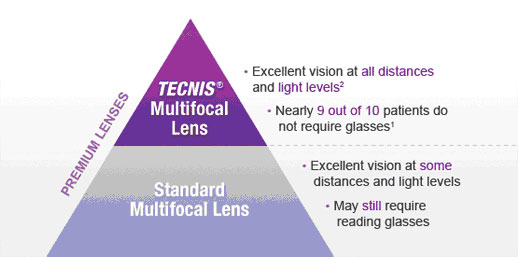When having cataract surgery you now have a few different artificial intraocular lenses (IOLs) to choose from. Currently, during cataract surgery your natural lens is removed and replaced with an artificial intraocular lens. The technology of these IOLs have vastly evolved from people having to wear very thick glasses after surgery to patients now being able to see 20/20 after surgery without wearing glasses.
IOLs have been around since the mid 1960's, though the first FDA approval for one occurred in 1981. Before that, if you had cataracts removed, you had to still wear very thick eyeglasses or special contact lenses in order to see afterwards because there was no artificial one to replace it. The cataract surgery itself was considered very dangerous and would have patients hospitalized for many days with sandbags on both sides of their head so they wouldn't go blind. Now the surgery is painless, done in minutes, and has you seeing great and feeling great in an hour.
Today, the IOLs that are offered solve more vision problems than ever, and doctors are advising their patients to have the surgery a lot sooner because of the great outcomes and for the overall safety that great eyesight gives you.
Choosing the right lens depends on your overall eye health and your visual needs. Below is some information we hope you can find useful, but overall it is best to make an appointment to come see our outstanding cataract surgeons and discuss what options are best for you.
Monofocal IOL

Monofocal IOL gives patients the option to see at a single point, usually at distance. This option requires the need for glasses for near, intermediate, and astigmatism correction.
Monofocal IOL are usually covered by the insurances including Medicare.
Tecnis Multi-focal Lens

Designed to give patients back their youthful vision, the TECNIS® Multifocal Lens provides patients with high-quality vision at any distance, and in any light condition—even in low light.
Superior Results

The advanced TECNIS® Multifocal is an implantable lens that restores vision after cataract surgery and corrects presbyopia (the need for reading glasses). It delivers results superior to those of a standard multifocal lens and offers an excellent chance to become spectacle independent.
Exceptional Full Range of Vision
Only the advanced TECNIS® Multifocal Lens enables you to see clearly at near, intermediate, and far distances without glasses in all light conditions.(2)
Compare the following images. In the first image, which demonstrates vision with the TECNIS® Multifocal Lens, you can see the coffee cup close up, the dashboard at intermediate, as well as road signs in the distance—all clearly.

Now, compare the second image. This image demonstrates what you might see with a monofocal lens. Although the intermediate and distance vision is clear, notice how the coffee cup is now blurry.

Atlantis Eyecare Patients share their experience
Dr. Logan on Channel 6 at Laguna Woods
Our Patient Art Gilford had the Tecnis Multi-focal lens implanted and was featured on Abbott’s 2010 Annual Report.
Crystalens HD
Crystalens is an accommodating intraocular lens that can treat cataracts and presbyopia.
Accommodating means the action of the eye’s tiny ciliary muscles flexing and changing the position of the eye’s lens for focusing at different distances. With presbyopia the natural lens becomes less flexible due to aging.
The Crystalens IOL is uniquely fitted to the eyes’ muscles and uses them to flex and accommodate in the same way your natural lens once functioned.
Crystalens flexes as you focus your vision.
Crystalens HD, utilizes an optic design that is optimized to increase depth of focus – as a result it is designed to improve near vision without compromising intermediate or distance acuity. It features an enhanced accommodating optic that is designed to yield: improved depth of focus and improved near vision.
Crystalens is:
- The first and only FDA-approved accommodating intraocular lens
- The only FDA-approved intraocular lens that uses the natural focusing ability of the eye
- The only FDA-approved presbyopia correcting IOL for cataract patients that provides a single focal point throughout a continuous range of vision
Crystalens patients have reported less problems with glare, halos and night vision. Crystalens focuses only one image to the back of the eye, unlike a multifocal lens that projects multiple images, requiring your brain to “adjust” to the differences.
Many patients hardly ever wear glasses after surgery.
The unique Crystalens is designed to allow you to enjoy a fuller, more natural range of vision for most activities, including: reading a book, working on a computer, and driving a car.
Toric Lenses
Astigmatism is caused by the cornea being more curved in one direction than the other, causing blurred vision. Toric intraocular lenses (IOLs) are specially shaped IOLs designed to offset that imbalance.
Toric IOLs offer cataract patients or patients with presbyopia vision correction that reduces or eliminates corneal astigmatism and delivers significantly improved distance vision without the need for glasses or contacts.
Approximately 95% of patients with astigmatism see clearly with a Toric IOL.
Patients with a standard IOL who have astigmatism have about a 25% chance of seeing clearly without glasses.
Once implanted and aligned inside the eye, Toric IOLs stay fixed in place, which then results in eliminating pre-existing astigmatism.



